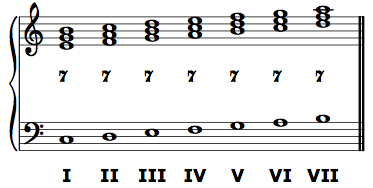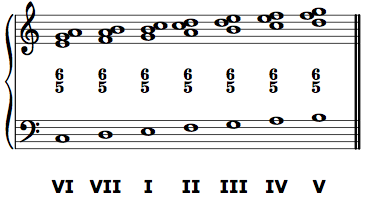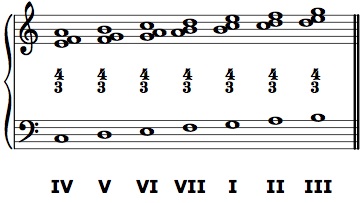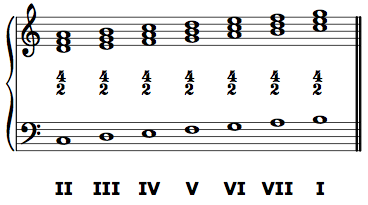Integrated Music Theory 2022-23
Discussion 3a - Triads
Class Discussion
“What is a triad?”
-
In tonal harmony, a triad is a chord with three notes made up of two thirds stacked on top of eachother.
-
The type of triad is determined by the quality of the thirds that make up the triad.
Triad Qualities
-
Four qualities of triads: Augmented, Major, Minor, and Diminished.
-
Augmented: M3 + M3. Creates an augmented fifth between the root and the fifth.
-
Major: M3 + m3. Creates a perfect fifth between the root and the fifth.
-
Minor: m3 + M3. Creates a perfect fifth between the root and the fifth.
-
Diminished: m3 + m3. Creates a diminished fifth between the root and the fifth.
-
Notice how none of the above triads use augmented thirds or diminished thirds.
Inversions of Triads
-
A root position triad with the root on the bottom (lowest note).
-
A first inversion triad has the chordal third on the bottom.
-
A second inversion triad has the chordal fifth on the bottom.
-
To “un-invert” a triad (turn it into root position) put the root on the bottom.
-
THE ROOT AND THE BASS NOTE OF A CHORD ARE NOTE THE SAME.
Inversion Figures
-
Root Position: 5/3 (or no inversion figure)
-
First Inversion: 6 (6/3)
-
Second Inversion: 6/4
Class Discussion 2021
Tertian Harmnoy: Harmony based on stacked thirds. (diatonic triad, stacked thirds, is not necessarily the same as a “triad”-implies any collection of three pitches) Quartal/Quintal Harmony (Stacked 4th’s/5th’s), not what we primarily study, but still important to keep in mind.
Use of the Word:Third -As an interval measurement -As a scale degree -As a chord descriptor
ID Triads?
- M: M3 + m3 (P5 outside)
- m: m3 + M3 (P5 outside)
- d: m3 + m3 (d5 outside)
- A: M3 + M3 (A5 outside)
Note that all 3rds are either major or minor! Don’t even worry about diminished thirds. We only have these 4 types of triads (in Tertian Harmony), Any adjustment of the structure of these 4 triad typs results in creating a different triad from the 4 types.
Additional tips:
- Knowing your scales can help identify triads, especially in a key with lots of sharps or flats where many of the possible altered notes are double sharps or flats.
- Possible groupings for memorization
- M and A both “start” with a M3, m and d both start with a m3
- M and m are more familiar whereas A and d are newer and “weirder,” have altered 5ths
- If you know your A major scale (as an example), you know your A major triad (root, third, fifth).
- If you know your A minor scale, you know your A minor triad.
ID inversions?
- Root position: starting point (stacked thirds). No inversion figures.
- Determine the quality of the third and the quality of the fifth to find the quality of the chord.
- 1st inversion: take the root and move it to the top (3rd is on the bottom). Inversion figure of superscript 6
- 2nd inversion: take the third and move it to the top (5th is on the bottom). Inversion figure of superscript 6 over 4 (6/4)
NOTE: The bass note of the chord (triad or otherwise) gives you the inversion figure (not the root, but the bass note could be the root). The root of the chord provides the quality of the chord (as it relates to the other tones in the chord).
- The only thing that determines your inversion is the lowest/bass pitched note.
- The inversion figures are based on the interval between the bass note and the other notes in the triad. The 5 and 3 in root position and first inversion are assumed. (note that when actually labeling inversions, the numbers will be superscript and stacked)
ID closed vs open voicing?
- Closed voicing = closest notes can be notated together on a staff, open = spread out? (No: “spread out” is not specific enough)
- Closed voicing = voices within a 4th, open = voices larger apart than a 4th? (On the right track, but not quite!)
- Closed voicing = within an octave, open voicing = greater than an octave?
These are all good guesses, but closed voicing means stacking all chord members in ascending order without skipping over any of them. Open voicing is anything but that.
- Open voicing = does not have the first/third/fifth in the same octave.
- Closed is in the same octave and stacked as closely to the bottom as possible. There are no skipped pitches.
Voicing is important because it changes how the listener hears something. Open has a more broad and expansive sound while closed is more final.
Further Reading
From Open Music Theory
A chord is any combination of three or more pitch classes that sound simultaneously.
A three-note chord whose pitch classes can be arranged as thirds is called a triad.
To quickly determine whether a three-note chord is a triad, arrange the three notes on the “circle of thirds” below. The pitch classes of a triad will always sit next to each other.
Identifying and labeling triads
Triads are identified according to their root and quality.
Triad roots
To find a triad’s root, arrange the pitch classes on a circle of thirds (mentally or on paper). The root is the lowest in the three-pitch-class clump. Expressed another way, if the circle ascends by thirds as it moves clockwise, the root is the “earliest” note (thinking like a literal clock), and the other pitch classes come “later.”
Once you know the root, you can identify the remaining notes as the third of the chord (a third above the root) and the fifth of the chord (a fifth above the root).
Triad qualities
To find a triad’s quality, identify the interval between the root and the other members of the chord. There are four qualities of triads that appear in major and minor scales, each with their own characteristic intervals.
- major triad: M3 and P5 above the root (as in do–mi–sol)
- minor triad: m3 and P5 above the root (as in do–me–sol or la–do–mi)
- diminished triad: m3 and d5 above the root (as in ti–re–fa)
- augmented triad: M3 and A5 above the root (as in me–sol–ti)

Building a triad
To build a triad on the staff, identify the root, quality, and bass note from the lead-sheet symbol. The root and quality will tell you what three pitch classes belong to the triad. For example, C+ tells you the root is C, and the quality is augmented. Since the quality is augmented, there is a major third above the root (E) and an augmented fifth above the root (G-sharp). Since there is no bass note appended to the lead-sheet symbol, the bass note is the same as the root: C. Write a C on the staff (in any comfortable register), then write the other chord tones (E and G-sharp) above the C (see the Caug triad in the above figure).
For Cm/E♭, the root is C, and the quality is minor. Since the quality is minor, there is a minor third above the root (E-flat) and a perfect fifth above the root (G). The slash identifies E-flat as the bass note. Write the E-flat on the staff. Then write a C and a G above it to complete the chord (again, see above).
When all the members of the triad are as close to the bass note as they can be, the chord is in what is called close position (C, Cm/E♭, and Cdim/G♭ above). When there are spaces between chord tones, the chord is in open position (Caug above). (In certain musical situations, only one of those positions will be useful or desirable.)
Listening to triads
Each triad quality has its own distinct sound, and to an extent that sound is preserved even when the chord is inverted (when the pitch classes are arranged so that a pitch class other than the root is in the lowest voice). As you practice identifying and writing triads, be sure to play the triads, both to check your analysis/writing and to develop the ability to identify chord qualities quickly by ear.
Inversions
Both bass lines and root progressions are important for the study and mastery of tonal harmony. Most of our work will focus on the bass lines, and what follows will help you analyze the root progressions present in any figured bass line. In other words, this will help you perform a Roman numeral analysis of a figured bass line.
Note that on the charts below, generic capital Roman numerals are provided.
Chords of the fifth
In any chord of the fifth (“root position”: 5/3 or 7/5/3 chord), the bass note and the root of the chord are the same. The Roman numeral to be assigned to any chord of the fifth, then, is the scale degree of its bass note. If do is in the bass, the bass is scale-degree 1, and the Roman numeral is I. If re is in the bass, the Roman numeral is II. And so on.


“First-inversion” chords of the sixth
Chords of the sixth that take the figures 6/3 or 6/5/3 are first-inversion chords. They are so named because the third of the chord (the next chord member above the root) is in the lowest voice. However, thinking about inversions while performing an analysis can be cumbersome. It is often simpler to remember that if the figure is 6/3 or 6/5/3 (or an abbreviation such as 6 or 6/5), the root of the chord is the sixth above the bass. If mi is in the bass, and the figure is “6”, the root is do, and the Roman numeral is I. If fa is in the bass and the figure is “6/5”, the root is re, and the Roman numeral is II. And so on.


“Second-inversion” chords of the sixth
Chords of the sixth that take the figures 6/4 or 6/4/3 (or an abbreviation such as 4/3) are second-inversion chords. They are so named because the fifth of the chord (the second member of the chord above the root) is in the lowest voice. Again, it is often simpler to remember that for 6/4, 6/4/3, and 4/3 chords, the root is the fourth above the bass. If re is in the bass, and the figure is 4/3, the root is sol, and the Roman numeral is V.


“Third-inversion” chords of the sixth
Chords of the sixth that take the figure 6/4/2 (or its abbreviation 4/2 or simply 2) are third-inversion chords. Their root is a second, or a step, above the bass. The most common 4/2 chord has fa in the bass, and sol is its root, making its Roman numeral V.


